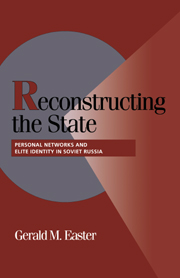Book contents
- Frontmatter
- Contents
- Preface
- 1 Introduction: Explaining State-Building Outcomes and the Soviet Russian Case
- Part I Structure and Identity in the Postrevolutionary State Elite
- Part II Informal Sources of Power in the Postrevolutionary State
- Part III Intrastate Conflict and the Constraints of Power Redefined
- 6 Center and Regions in Conflict I: Collectivization and the Crisis of Regional Leadership
- 7 Center and Regions in Conflict II: The Fall of the Provincial Komitetchiki
- 8 Conclusion: State Building and the Soviet Russian Case Reconsidered
- Notes
- Bibliography
- Index
- Titles in the series
8 - Conclusion: State Building and the Soviet Russian Case Reconsidered
Published online by Cambridge University Press: 13 October 2009
- Frontmatter
- Contents
- Preface
- 1 Introduction: Explaining State-Building Outcomes and the Soviet Russian Case
- Part I Structure and Identity in the Postrevolutionary State Elite
- Part II Informal Sources of Power in the Postrevolutionary State
- Part III Intrastate Conflict and the Constraints of Power Redefined
- 6 Center and Regions in Conflict I: Collectivization and the Crisis of Regional Leadership
- 7 Center and Regions in Conflict II: The Fall of the Provincial Komitetchiki
- 8 Conclusion: State Building and the Soviet Russian Case Reconsidered
- Notes
- Bibliography
- Index
- Titles in the series
Summary
Soviet Russia was long considered by Western scholars to be a strong state. The underlying source of its strength was presumed to be the formal structure of the Bolshevik party, the “organizational weapon” forged by Lenin in the revolutionary struggle to depose Russia's old regime. The subsequent collapse of the Soviet state ultimately laid bare the conceptual limitations of this long-standing conventional wisdom. The case study presented here offered a reconceptualization of the Soviet state, emphasizing its informal sources of power – personal networks and elite identity. This concluding chapter suggests that the findings of the case study offer a solution to three puzzles found in the scholarly literature on Soviet Russia and comparative state theory: (1) Does reconstructing personal network ties and uncovering sources of elite status among the Bolsheviks contribute something new to an understanding of state building in postrevolutionary Soviet Russia? (2) Does this reexamination of the building process provide insight into the subsequent collapse of the Soviet state? and (3) Does this reexamination of the Soviet Russian case offer anything new to the recent efforts of comparative theorists to explain state-Building outcomes?
To begin, the case study focused attention on the informal power resources of an intrastate elite cohort, the Provincial Komitetchiki. Moreover, it showed how these informal power resources were deployed to facilitate the process of building a state capacity for territorial administration in the postrevolutionary state.
- Type
- Chapter
- Information
- Reconstructing the StatePersonal Networks and Elite Identity in Soviet Russia, pp. 161 - 174Publisher: Cambridge University PressPrint publication year: 2000

